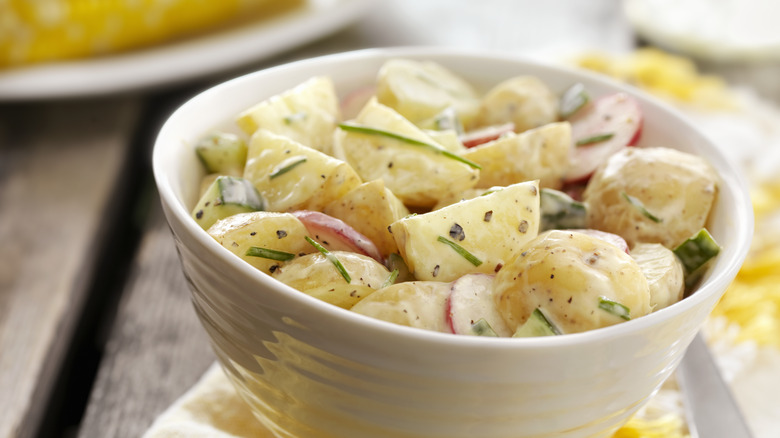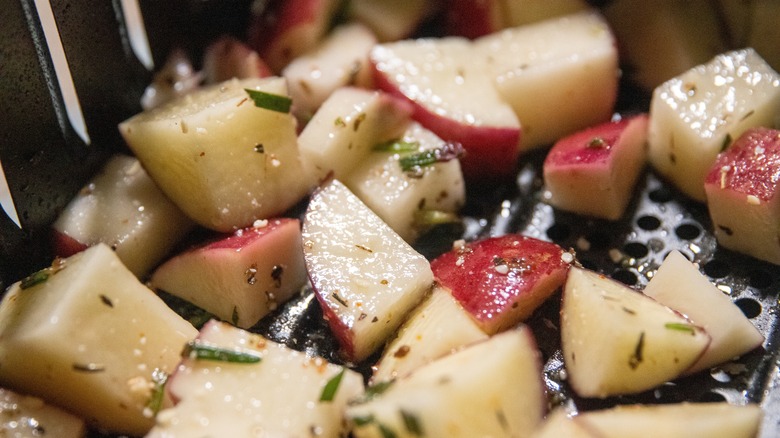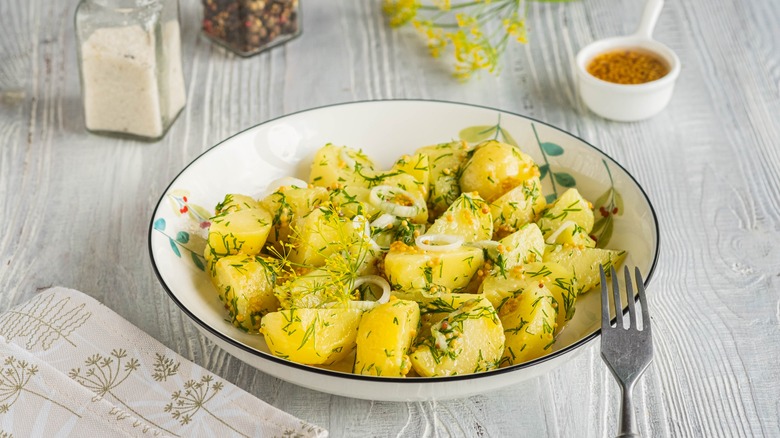Why An Air Fryer Is Key To Prevent Soggy Potato Salad
If there's one crowd-pleasing dish you can count on appearing at a summer potluck or backyard barbecue, it's potato salad. From Russia to Ethiopia, the staple side graces tables around the world as different countries serve distinct takes on potato salad. While the main ingredient stays the same, the spuds are often accompanied by other veggies, a protein or two, and plenty of seasonings from flavorful spices to fragrant herbs. And, of course, no potato salad is complete without some sauce. Whether it's a creamy mayonnaise-based condiment or a fresh, tangy vinaigrette, a little dressing goes a long way. Naturally, it's easy for the dish to end up too well-dressed, resulting in a somewhat soggy and unsatisfying potato salad. The good news is that you can stop a textural disaster in its tracks by crisping up the potatoes in an air fryer before dressing them.
Not only can the versatile kitchen appliance be used to make leftover potato salad extra crispy for maximum enjoyment, but the air fryer comes in handy for taking care of potato prep, too. While most potato salad recipes call for simply boiling the spuds, it might be worth popping the similarly sized pieces into an air fryer. The hot air circulating inside the basket makes the potatoes a little dryer so they soak up sauce a bit better. Besides the fact that each bite will be the perfect balance of soft inside and crispy outside, you won't have to worry about accidentally making a watery potato salad.
Air fry spuds for a crispier potato salad
While preparing potato salad with the help of an air fryer might seem unorthodox, it can make a world of difference when it comes to texture. Fortunately, the process is fairly flexible, as you can either boil your potatoes first and finish them in the air fryer or cook them fully in the countertop appliance. The exact approach you take may depend on what type of spuds you use and how close to tradition you'd like to stick.
If you opt for waxy or all-purpose potatoes, which contain less starch and don't need to be peeled, you can boil then strain them a few minutes early before tossing them into the air fryer to crisp up. Red- and gold-skinned types are commonly called for in potato salad recipes because they maintain their structure well when cooked in water after being cut, resulting in tender pieces that hold up when thoroughly mixed with other ingredients.
On the other hand, russet potatoes — the prototypical spud — are prone to becoming mushy if they aren't boiled whole, requiring extra time for cooling before they can be cut. Potato salad purists often suggest avoiding starchy potatoes because they can fall apart when cooked traditionally, but they're perfect for slicing and air frying from the start. Since they're better-suited to absorbing moisture, they could also be worth using over waxy potatoes if the goal is for your spuds to soak up dressing.
Tips for managing moisture in potato salad
Besides switching up your approach for how you cook your salad-bound spuds, there are a few other ways to ensure the final dish doesn't turn out soggy. For instance, it might be worth testing out some chef-approved strategies for dressing your potato salad. After all, the sauce itself — as well as how it's added — can certainly make a difference when it comes to how moist the salad ends up.
Since the side is so widely made, plenty of professionals have shared their special tips for preparing it, especially as far as seasoning is concerned. If you're trying to figure out when exactly to dress your potatoes, take a page out of Bobby Flay's book. Flay suggests adding dressing to the spuds while they're still hot, as the high temperature helps open up the pores of the potatoes so all the flavors and moisture can soak in more thoroughly. Meanwhile, the chef who brought French cooking to the American masses also had a smart method for ensuring the classic salad's sauce ends up stuck to the potatoes: If you boil your potatoes before air frying them, test out Julia Child's tip to mix some of the starchy water into the dressing. This can help better bind all the ingredients together, so moisture won't end up pooling in the bottom of the bowl. Regardless of how exactly you dress your potato salad, remember to be mindful not to use too much sauce — you can always add more later as needed.


